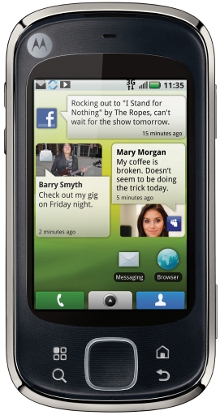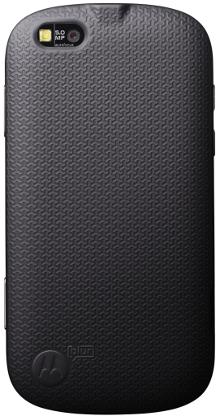Motorola’s latest Android handset offers multi-touch
Feb 15, 2010 — by Eric Brown — from the LinuxDevices Archive — viewsMotorola announced an Android smartphone with a 3.1-inch touchscreen, pinch-and-zoom, a touchpad, Adobe Flash Lite, Swype predictive input, and the MotoBlur UI layer. The rubber-gripped phone will be called the “Quench” in unnamed markets around the world, but will be offered exclusively in the U.S. by T-Mobile as the “Cliq XT.”
In its Cliq XT incarnation, the Quench appears to be intended as the next-generation version of Motorola's first Android phone, the T-Mobile-sold Cliq. However, the company did not list which global carrier(s) would pick up the Quench version.
The Quench/Cliq XT follows shortly after the announcement of a somewhat similarly configured mid-market "Devour" Android phone for Verizon Wireless. This in turn followed other Motorola Android phones including the Droid (Verizon), Backflip (reportedly heading for AT&T), and the Motoroi (SK Telecom in Korea).


Motorola Quench
(Click on either to enlarge)
For cellular communications, the Quench supports WCDMA (in both U.S. and global bands), as well as GSM, HSDPA (7.2Mbps), EDGE Class 12, and GPRS Class 12, says Motorola. Other features are said to include WiFi, Bluetooth 2.0, aGPS, USB 2.0, and a five-megapixel camera with autofocus and LED flash.
Measuring 2.3 x 4.6 x 0.5 inches (59.4 x 116.7 x 12.3mm), the Quench weighs 4.4 ounces (123.5g), and runs on a 1420mAh battery touted for its 6.5 hour talk time and 13.5-day standby duration. The phone supports a wide variety of audio and video playback formats, including video playback and recording of MPEG video at 24 frames per second (fps) at HVGA resolution, says Motorola. The Quench is also said to offer dual microphones and noise cancellation technology.
Multi-touch, voice control, and Swype
The Quench runs the now somewhat dated Android 1.5 ("Cupcake"), yet supplies a number of advanced features, most notably pinch-to-zoom multi-touch support. The Quench also offers voice-activated search (English only), as well as the Swype virtual keyboard technology, says the company. Swype, which had its Android debut last week on the new HTC/T-Mobile MyTouch 3G 3.5mm, is claimed to permit text input at over 50 words per minute via continuous finger or stylus motions.
Multimedia software includes Adobe Flash Lite as well as MotoBlur's new "connected media player," which integrates with social networking sites, says the company. The player lets users buy and download music from an MP3 store while integrating third-party apps such as TuneWiki, SoundHound, GoTV, and YouTube, says Motorola. Users can share tracks with friends, find lyrics, watch videos, and stream FM radio, says the company. The player is also said to include a music search feature, as well as "synchronized lyrics in any language."
The MotoBlur UI layer works closely with the MotoBlur "push" web service, which streams integrated messaging and social networking updates data to the user. This interface integrates communications ranging from email to social networking activity, streaming together and syncing updates to contacts, posts, messages, photos, and data.
Other Quench software includes the Android WebKit HTML browser, as well as Google Maps with turn-by turn-directions, and access to Android Market. As with the Backflip and Devour, the Quench lets users access the phone over the web, enabling them to erase all data in case the phone is lost or stolen. Users can also locate the phone via GPS, and the user name and password can also be restored remotely, says Motorola.
Motorola ready to split
On Friday, Motorola announced that the company plans to go through with plans to separate into two independent, publicly traded companies later this quarter. One company will include the Mobile Devices and Home businesses that manufactures Android phones, and the other includes the Enterprise Mobility Solutions and Networks businesses. The Mobile Devices and Home business business will offer mobile converged devices, digital entertainment devices in the home, and end-to-end video, voice and data solutions, says Motorola.
The proposed tax-free spin-off is expected to be accomplished through a pro rata distribution to Motorola shareholders, says the company. Following the separation, the Mobile Devices and Home business is expected to own the Motorola brand and license it royalty-free to the Enterprise Mobility Solutions and Networks business, enabling both companies to use the Motorola brand.
The companies have been operating more or less indepently since August 2008 when Sanjay Jha was named co-CEO of Motorola and CEO of Motorola Mobile Devices and Home business. The staffing announcement followed an earlier announcement of the planned split-up of the giant after a series of disappointing sales reports. Greg Brown has held a similar joint co-CEO/CEO title for the Enteprise business. Both Jha and Brown will continue to act as CEO of their respective companies.
Stated Jha, "The combination of Mobile Devices and our Home business brings together two highly complementary and innovative organizations. Together we will be best positioned to lead in the convergence of mobility, media, and the Internet. Our expanding portfolio of smartphones and end-to-end video content delivery capabilities will enable us to provide advanced mobile media solutions and multi-screen experiences for our customers."
Availability
Motorola's Quench will be available in multiple regions around the globe beginning in Q1 2010, and the Cliq XT will be available exclusively through T-Mobile USA beginning next month. Pricing was not detailed.
More information may eventually be found at Motorola, here, or at T-Mobile, which has yet to formally announce the Cliq XT, here.
This article was originally published on LinuxDevices.com and has been donated to the open source community by QuinStreet Inc. Please visit LinuxToday.com for up-to-date news and articles about Linux and open source.